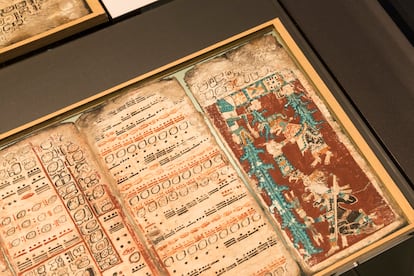The Mayans followed the movements of the moon for years to predict eclipses.

Without the mathematics of the Babylonians, the Maya achieved great precision in predicting eclipses. How they did this remains a matter of debate, as no manual of Mayan astronomy survives. In fact, the surviving texts from that civilization can be counted on the fingers of one hand, and some would be left over. One of them, the most complex but best preserved, is the Dresden Codex . Comprised of 39 pages made from the paste of tree bark, its 3.56 meters long contains ritual and divinatory calendars, astronomical and meteorological tables, ritual instructions, and numerous representations of gods. It was key in its time to deciphering Mayan hieroglyphics. Now, a review of its astronomical section provides new clues as to how they predicted eclipses.
“The Dresden Codex eclipse table was part of a long tradition in which experts were incorporating adjustments generation after generation to improve it,” says Justin Lowry, an archaeologist at the State University of New York at Plattsburgh (United States) and co-author of this new research published in Science Advances . This table in the Mayan text was known to be related to eclipses for more than a century, but how it worked exactly is unknown. The key lies in the lunar cycles.
In Mayan cities, there existed a figure who could be called the guardians of the days, those in charge of measuring time, but also of the rituals surrounding its passage. These guardians measured the succession of days based on the lunar month, counted from the first crescent moon after the new moon. The phases of the satellite are relevant: lunar eclipses occur when the Moon is at full moon, while solar eclipses occur at new moon. The Dresden Codex records 405 lunar cycles or months between the first eclipse and the last, which concludes the table.
“What we maintain is that the adjustments, the changes, were made in the middle of the table,” says Lowry, who emphasizes that those day watchers were very pragmatic; their knowledge was based on observation. “Think that if you're looking at the sky and see that when there's a [solar] eclipse it's always with a new moon, you'll relate a new moon to an eclipse. That's how they must have looked and counted until the next new moon.” But there isn't a solar eclipse with every new moon, just as there isn't a lunar eclipse with every full moon. There are only two possible times for these phenomena to occur: during the Moon's nodes, that is, when it crosses the ecliptic, that apparent curved line along which the Sun moves. The rest of its orbit is not in the same plane as the planet, so it couldn't hide the star or allow the Earth to pass between them. Consequently, a lunar eclipse can only occur when the full Moon is near a lunar node, so a solar eclipse can only occur when the new Moon is approaching one of the two.

"I don't think the Maya were familiar with the phenomenon of the nodes, but they must have known there was something there," Lowry maintains. It was with the succession of lunar months and eclipses that they adjusted the table, modifying it with each new eclipse. When the lunar phase is new and the satellite is at the center of the node, a total eclipse occurs; if it is two days away from reaching it or has already passed, a partial eclipse occurs. "The Maya were able to better predict when the new moon was closest to the node through observation," the archaeologist adds.
In the Dresden Codex, researchers have also confirmed that those day watchers, a figure that still exists in indigenous communities in southern Mexico and Guatemala, not only predicted the eclipses they would see, that is, those occurring in their area of the sky. “The table also predicted eclipses they wouldn't see. Based on the lunar calendar, it predicted those that would occur in other parts of the world,” Lowry points out. When comparing the codex table with NASA's record of eclipses over the past 5,000 years , the accuracy was very high. For the American archaeologist, an expert on Mayan civilization, for these people, “eclipses were seen as something dangerous, so those predicted but not seen would be a success of their rituals,” Lowry concludes. Thus, the Dresden Codex, which is full of rituals, would help prevent the arrival of darkness.
The most intriguing thing about this prediction framework is that it was all based on the Tzolk'in , “a 260-day calendar they used to determine the fate of individuals based on their birth date,” says John Justeson, professor emeritus at the State University of New York at Albany and co-author of the study, in a note. What they point out in their study is that the eclipse table “evolved from a more general table of successive lunar months: Maya diviners discovered that 405 new moons almost always corresponded exactly to 46 of these 260-day cycles,” Justeson details. The Maya also discovered that, within their 260-day calendar, solar eclipses usually occurred on or very close to each other. “Over time, their lunar calendar made it possible to develop a procedure for anticipating the dates on which a solar eclipse might occur locally,” the professor adds.
Stanislaw Iwaniszewski, an archaeoastronomer at Mexico's National Institute of Anthropology and History, agrees with the study's authors that "the Maya developed their lunar count, and the information gathered allowed them to anticipate the dates of solar eclipses." Unrelated to this research, Iwaniszewski considers it "extremely interesting, based on statistical computations taken from the eclipse tables on the NASA website" and adds: "I fully agree that the structure of the table is derived from observations of lunar eclipses. There is no other way to create the tables." However, he misses the inclusion of other data on eclipses collected on stelae and believes that Lowry and Justeson's "interpretation is not the only one."
EL PAÍS




